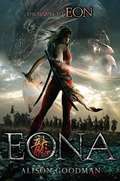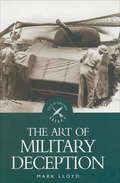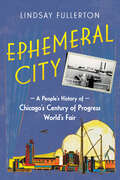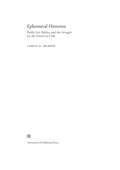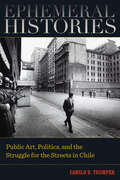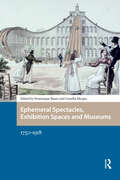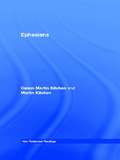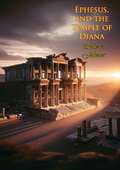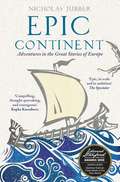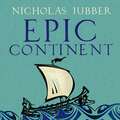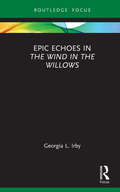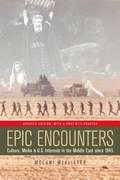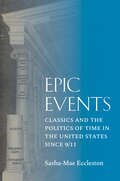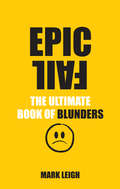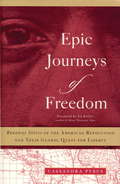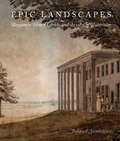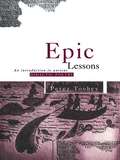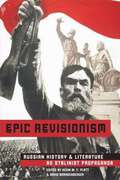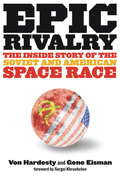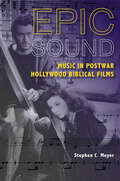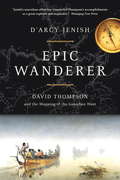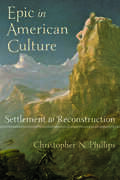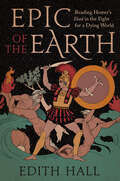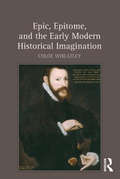- Table View
- List View
Eona: The Last Dragoneye (Eon #2)
by Alison GoodmanEon has been revealed as Eona, the first female Dragoneye in hundreds of years. Along with fellow rebels Ryko and Lady Dela, she is on the run from High Lord Sethon's army.
Epehy: Hindenburg Line (Battleground Ser.)
by Bill MitchinsonThe village of Epehy gave its name to one of the most important battles of 1918.Evacuated by the Germans during their retreat to the Hindenburg Line, the ruins were occupied by British Forces until the German offensive. They were recaptured in some of the bloodiest engagements of September 1918.
Ephemeral City: A People's History of Chicago's Century of Progress World's Fair
by Lindsay FullertonLess celebrated than the 1893 Chicago World’s Fair, the 1933–1934 Century of Progress Exposition brought visitors face-to-face with gleaming American consumerism in the midst of the Great Depression. Lindsay Fullerton draws on a wealth of personal photographs, scrapbooks, oral histories, and writings to illuminate the wildly different experiences of fairgoers against the backdrop of a city steeped in poverty and segregation. The Exposition took place amidst massive changes sparked by expansion of mass media, Franklin Roosevelt’s election, the repeal of Prohibition, and the Great Migration. A diverse cross-section of Chicagoans informs Fullerton’s history of the event in the context of the fast-changing America of the interwar era. These personal accounts tell stories of how attendees interpreted their own experiences while being surrounded by whiz-bang products and full-throated evangelism on the benefits of progress. A colorful people’s history, Ephemeral City takes readers inside the other Chicago World’s Fair and how visitors interacted with a pivotal moment in American history.
Ephemeral Histories: Public Art, Politics, and the Struggle for the Streets in Chile
by Camilo D. TrumperPolitics under Salvador Allende was a battle fought in the streets. Everyday attempts to "ganar la calle" allowed a wide range of urban residents to voice potent political opinions. Santiaguinos marched through the streets chanting slogans, seized public squares, and plastered city walls with graffiti, posters, and murals. Urban art might only last a few hours or a day before being torn down or painted over, but such activism allowed a wide range of city dwellers to participate in the national political arena. These popular political strategies were developed under democracy, only to be reimagined under the Pinochet dictatorship. Ephemeral Histories places urban conflict at the heart of Chilean history, exploring how marches and protests, posters and murals, documentary film and street photography, became the basis of a new form of political change in Latin America in the late twentieth century.
Ephemeral Histories: Public Art, Politics, and the Struggle for the Streets in Chile
by Camilo D. TrumperPolitics under Salvador Allende was a battle fought in the streets. Everyday attempts to "ganar la calle" allowed a wide range of urban residents to voice potent political opinions. Santiaguinos marched through the streets chanting slogans, seized public squares, and plastered city walls with graffiti, posters, and murals. Urban art might only last a few hours or a day before being torn down or painted over, but such activism allowed a wide range of city dwellers to participate in the national political arena. These popular political strategies were developed under democracy, only to be reimagined under the Pinochet dictatorship. Ephemeral Histories places urban conflict at the heart of Chilean history, exploring how marches and protests, posters and murals, documentary film and street photography, became the basis of a new form of political change in Latin America in the late twentieth century.
Ephemeral Spectacles, Exhibition Spaces and Museums: 1750-1918 (Spatial Imageries in Historical Perspective)
by Dominique Bauer Camilla MurgiaThis book examines ephemeral exhibitions from 1750 to 1918. In an era of acceleration and elusiveness, these transient spaces functioned as microcosms in which reality was shown, simulated, staged, imagined, experienced and known. They therefore had a dimension of spectacle to them, as the volume demonstrates. Against this backdrop, the different chapters deal with a plethora of spaces and spatial installations: the Wunderkammer, the spectacle garden, cosmoramas and panoramas, the literary space, the temporary museum, and the alternative exhibition space.
Ephesians (New Testament Readings)
by Martin Kitchen Canon Martin KitchenThis study approaches the Epistle to the Ephesians in a radically different way from traditional commentaries. Rather than analysing each individual verse, Martin Kitchen examines the complete text within the framework of contemporary biblical criticism. He acknowledges the debt which biblical studies owes to historical method, while at the same time recognizing the need to view the Epistle against the background of recent literary approaches to New Testament texts. Ephesians also takes into account the important questions of whether the Epistle was written by St Paul and, if not, why it was written at all.This book will be valuable reading for all theologians, students of theology and ministers of religion.
Ephesus, and the Temple of Diana
by Edward Falkener"Ephesus, and the Temple of Diana" is a captivating exploration of one of the ancient world's most magnificent cities and its renowned temple. Written by Edward Falkener, this detailed historical and archaeological study delves into the grandeur and significance of Ephesus, a prominent city of antiquity located in what is now modern-day Turkey. The book provides an in-depth examination of the Temple of Diana (Artemis), one of the Seven Wonders of the Ancient World.Falkener meticulously documents the history, architecture, and cultural importance of the Temple of Diana, presenting a comprehensive narrative that brings the ancient city to life. The author combines historical texts, archaeological findings, and his own insightful analysis to offer readers a vivid picture of Ephesus and its monumental temple. Rich with illustrations, diagrams, and detailed descriptions, this book serves as an invaluable resource for historians, archaeologists, and enthusiasts of ancient history.Through Falkener's scholarly yet accessible writing, readers will gain a profound understanding of the religious, social, and architectural achievements of Ephesus and its iconic temple. This book is an essential addition to the library of anyone interested in the wonders of the ancient world and the legacy of classical civilizations.
Epic Continent: Adventures in the Great Stories of Europe
by Nicholas JubberThese are the stories that made Europe.Journeying from Turkey to Iceland, award-winning travel writer Nicholas Jubber takes us on a fascinating adventure through our continent's most enduring epic poems to learn how they were shaped by their times, and how they have since shaped us. The great European epics were all inspired by moments of seismic change: The Odyssey tells of the aftermath of the Trojan War, the primal conflict from which much of European civilisation was spawned. The Song of the Nibelungen tracks the collapse of a Germanic kingdom on the edge of the Roman Empire. Both the French Song of Roland and the Serbian Kosovo Cycle emerged from devastating conflicts between Christian and Muslim powers. Beowulf, the only surviving Old English epic, and the great Icelandic Saga of Burnt Njal, respond to times of great religious struggle - the shift from paganism to Christianity. These stories have stirred passions ever since they were composed, motivating armies and revolutionaries, and they continue to do so today.Reaching back into the ancient and medieval eras in which these defining works were produced, and investigating their continuing influence today, Epic Continent explores how matters of honour, fundamentalism, fate, nationhood, sex, class and politics have preoccupied the people of Europe across the millennia. In these tales soaked in blood and fire, Nicholas Jubber discovers how the world of gods and emperors, dragons and water-maidens, knights and princesses made our own: their deep impact on European identity, and their resonance in our turbulent times.
Epic Continent: Adventures in the Great Stories of Europe
by Nicholas JubberShortlisted for the Stanford Dolman Travel Book of the Year 2020Award-winning travel writer Nicholas Jubber journeys across Europe exploring Europe's epic poems, from the Odyssey to Beowulf, the Song of Roland to the Nibelungenlied, and their impact on European identity in these turbulent times. These are the stories that made Europe.Journeying from Turkey to Iceland, award-winning travel writer Nicholas Jubber takes us on a fascinating adventure through our continent's most enduring epic poems to learn how they were shaped by their times, and how they have since shaped us. The great European epics were all inspired by moments of seismic change: The Odyssey tells of the aftermath of the Trojan War, the primal conflict from which much of European civilisation was spawned. The Song of the Nibelungen tracks the collapse of a Germanic kingdom on the edge of the Roman Empire. Both the French Song of Roland and the Serbian Kosovo Cycle emerged from devastating conflicts between Christian and Muslim powers. Beowulf, the only surviving Old English epic, and the great Icelandic Saga of Burnt Njal, respond to times of great religious struggle - the shift from paganism to Christianity. These stories have stirred passions ever since they were composed, motivating armies and revolutionaries, and they continue to do so today.Reaching back into the ancient and medieval eras in which these defining works were produced, and investigating their continuing influence today, Epic Continent explores how matters of honour, fundamentalism, fate, nationhood, sex, class and politics have preoccupied the people of Europe across the millennia. In these tales soaked in blood and fire, Nicholas Jubber discovers how the world of gods and emperors, dragons and water-maidens, knights and princesses made our own: their deep impact on European identity, and their resonance in our turbulent times.(P)2019 Hodder & Stoughton Limited
Epic Echoes in The Wind in the Willows (Routledge Focus on Classical Studies)
by Georgia L. IrbyThis book explores Grahame’s engagements with classical antiquity in The Wind in the Willows, including ancient epic, parody (Batrachomyomachia), and pastoral imagery. Irby demonstrates how subtle echoes – such as the structure of twelve books, arming scenes, epic catalogues, anabases and katabases, lying tales, Toad’s "cleverness" – cumulatively suggest a link between The Wind in the Willows and classical literature. This study offers the first sustained treatment of classical allusions in The Wind in the Willows, considering the entire novel, not isolated scenes, building on existing scholarship to yield an interpretation through the lens of classical literature and its reception in Victorian and Edwardian England. This volume will provide a unique resource for students and scholars of classical reception and literature, as well as comparative literature, English literature, children’s literature, gender studies, and Grahame’s writing.
Epic Encounters: Culture, Media, and U. S. Interests in the Middle East Since 1945
by Melani McAlisterEpic Encounters examines how popular culture has shaped the ways Americans define their "interests" in the Middle East. In this innovative book--now brought up-to-date to include 9/11 and the Iraq war--Melani McAlister argues that U. S. foreign policy, while grounded in material and military realities, is also developed in a cultural context. American understandings of the region are framed by narratives that draw on religious belief, news media accounts, and popular culture. This remarkable and path breaking book skillfully weaves lively and accessible readings of film, media, and music with a rigorous analysis of U. S. foreign policy, race politics, and religious history. The new chapter, titled "9/11 and After: Snapshots on the Road to Empire," considers and brilliantly analyzes five images that have become iconic: (1) New York City firemen raising the American flag out of the rubble of the World Trade Center, (2) the televised image of Osama bin-Laden, (3) Afghani women in burqas, (4) the statue of Saddam Hussein being toppled in Baghdad, and (5) the hooded and wired prisoner in Abu Ghraib. McAlister's singular achievement is to illuminate the contexts of these five images both at the time they were taken and as they relate to current events, an accomplishment all the more remarkable since--to paraphrase her new preface--we are today struggling to look backward at something that is still rushing ahead.
Epic Events: Classics and the Politics of Time in the United States since 9/11
by Sasha-Mae EcclestonAn analysis of ancient Greek and Roman works alongside contemporary literature, exploring how these classics shape our understanding of the politics of time in America Ancient Greek and Roman cultures have been privileged as authoritatively timeless throughout American history. American leaders capitalize on this privilege when, during periods of crisis, they allude to these cultures to offer relief, to reestablish trust in the status quo, and to promote national unity. Analyzing texts that also draw on ancient Greek and Roman material to respond to these crises, Sasha-Mae Eccleston explains how contemporary authors and artists have questioned calls for unity that homogenize disparate experiences and ignore systemic inequality. Their engagements with the temporalities of the ancient material reveal how time structures membership in the national community. Reading, for example, Seneca&’s drama Medea, Homer&’s epics, and the verses of Sappho alongside Jesmyn Ward&’s novel Salvage the Bones or the poetry of Ocean Vuong and Juliana Spahr, Eccleston examines the temporal politics of major events and everyday life in the United States. Epic Events shows how ancient works that seem to insulate audiences from disaster can actually alert them to the frightening hierarchization of American life. Eccleston skillfully weaves together analyses of ancient material and contemporary texts that range from memorials, visual art, and literature to speeches and public health declarations to bring questions of race, class, and gender into dialogue with time in thoughtful, nuanced, and original ways.
Epic Fail: The Ultimate Book of Blunders
by Mark LeighHerewith a handful of sample entries to tickle your funny bones…In the 1824 war between Britain and Ashanti (now part of Ghana), the British Redcoats found themselves surrounded by 10,000 fierce Ashanti warriors, and running very low on ammunition. Their commander ordered Charles Brandon, the army’s stores manager, to break open the reserve ammunition he’d ordered. As the Ashanti advanced Brandon began to open the ammunition boxes – only to find he had brought the wrong supplies. They were all full of biscuits. The grandfather of film star Lana Turner owned a half share in a brand new company that had started bottling a fizzy drink. He thought the drink’s name would affect its saleability and wanted to change it – without success. In frustration and as a protest he sold his 50%. It’s a pity really because Coca-Cola became quite popular…Italian Vittoria Luise was out driving during a fierce storm in Naples. A huge gust of wind blew his car into the River Sele. The car began to sink, but the calm motorist managed to break a window and swim to safety. He dragged himself onto the riverbank – and it was here that he was hit by a falling tree and killed.The Times of 19 October 1986 carried the story of Emilio Tarra, a crewmember of the 1986 America’s Cup race, who was driving from Perth towards Adelaide during the Australian leg of the race. En route, his car sideswiped a kangaroo, leaving it sprawled across the road. Tarra got out of his car and, assuming the kangaroo was dead, decided to take a novelty photograph to show his colleagues. Dressing the kangaroo up in his smart team blazer, he propped it against his car to take its photograph. As he was focusing his camera, the kangaroo, which had only been stunned, woke up and bounded back off into the bush, taking with it the jacket, which contained Tarra’s passport, $2,000 worth of cash and his credit cards.
Epic Journeys of Freedom
by Cassandra PybusCassandra Pybus adds greatly to the work of [previous] scholars by insisting that slaves stand at the center of their own history . . . Her 'biographies' of flight expose the dangers that escape entailed and the courage it took to risk all for freedom. Only by measuring those dangers can the exhilaration of success be comprehended and the unspeakable misery of failure be appreciated.--Ira Berlin, from the ForewordDuring the American Revolution, thousands of slaves fled their masters to find freedom with the British. Epic Journeys of Freedom is the astounding story of these runaways and the lives they made on four continents. Having emancipated themselves, with the rhetoric about the inalienable rights of free men ringing in their ears, these men and women struggled tenaciously to make liberty a reality in their own lives.This alternative narrative of freedom fought for and won is uniquely compelling; historian Cassandra Pybus's groundbreaking research has uncovered individual stories of runaways who left America to forge difficult new lives in far-flung corners of the British Empire. Harry, for example, one of George Washington's slaves, escaped from Mount Vernon in 1776, was evacuated to Nova Scotia in 1783, and eventually relocated to Sierra Leone in West Africa with his wife and three children. Ralph Henry, who ran away from the Virginia firebrand Patrick Henry in 1776, took a similar path to precarious freedom in Sierra Leone, while others, such as John Moseley and John Randall, were evacuated with the British forces to England. Stranded in England without skills or patronage during a period of high unemployment, they were among thousands of newly freed poor blacks who struggled just to survive. While some were relocated to Sierra Leone, others, like Moseley and Randall, found themselves transported to the distant penal colony of Botany Bay, in Australia. Epic Journeys of Freedom, written in the best tradition of history from the bottom up, is a fascinating insight into the meaning of liberty; it will change forever the way we think about the American Revolution.From the Hardcover edition.
Epic Landscapes: Benjamin Henry Latrobe and the Art of Watercolor
by Julia A. SienkewiczWinner of College Art Association’s Wyeth Foundation for American Art Publication Grant Epic Landscapes is the first study devoted to architect Benjamin Henry Latrobe’s substantial artistic oeuvre from 1795, when he set sail from Britain to Virginia, to late 1798, when he relocated to Pennsylvania. Thus, this book offers the only extended consideration of Latrobe’s Virginian watercolors, including a series of complex trompe l’oeil studies and three significant illustrated manuscripts. Though Latrobe’s architecture is well known, his watercolors have received little critical attention. Epic Landscapes rediscovers Latrobe’s watercolors as an ambitious body of work and reconsiders the close relationship between the visual and spatial sensibility of these images and his architectural designs. It also offers a fresh analysis of Latrobe within the context of creative practice in the Atlantic world at the end of the eighteenth century as he explored contemporary ideas concerning the form of art for Republican society and the social impacts of revolution.
Epic Lessons: An Introduction to Ancient Didactic Poetry
by Peter TooheyDidactic Epic was enormously popular in the ancient world. It was used to teach Greeks and Romans technical and scientific subjects, but in verse. Epic Lessons shows how this scientific poetry was intended not just to instruct but also to entertain.Praise for its predecessor, Reading Epic'Toohey's erudition makes the complexities and the strangeness of these ancient poems appear as clear as daylight and his enthusiasm renders them as attractive as the latest blockbuster.' - JACT Review
Epic Revisionism: Russian History and Literature as Stalinist Propaganda
by Kevin M. F. PlattFocusing on a number of historical and literary personalities who were regarded with disdain in the aftermath of the 1917 revolution—figures such as Peter the Great, Ivan the Terrible, Alexander Pushkin, Leo Tolstoy, and Mikhail Lermontov—Epic Revisionism tells the fascinating story of these individuals’ return to canonical status during the darkest days of the Stalin era. An inherently interdisciplinary project, Epic Revisionism features pieces on literary and cultural history, film, opera, and theater. This volume pairs scholarly essays with selections drawn from Stalin-era primary sources—newspaper articles, unpublished archival documents, short stories—to provide students and specialists with the richest possible understanding of this understudied phenomenon in modern Russian history.
Epic Rivalry: Inside the Soviet and American Space Race
by Von HardestyWhen Neil Armstrong and Buzz Aldrin walked on the moon in 1969, they personified an almost unimaginable feat - the incredibly complex task of sending humans safely to another celestial body. This extraordinary odyssey, which grew from the rivalry between the United States and the Soviet Union during the Cold War, was galvanized by the Sputnik launch in 1957. Written by Smithsonian curator Von Hardesty and researcher Gene Eisman, Epic Rivalry tells the story from both the American and the Russian points of view, and shows how each space-faring nation played a vital role in stimulating the work of the other. Scores of rare, unpublished, and powerful photographs recall the urgency and technical creativity of both nations' efforts. The authors recreate in vivid detail the parallel universes of the two space exploration programs, with visionaries Wernher von Braun and Sergei Korolev and political leaders John F. Kennedy and Nikita Khrushchev at the epicenters. The conflict between countries, and the tense drama of their independent progress, unfolds in vivid prose. Approaching its subject from a uniquely balanced perspective, this important new narrative chronicles the epic race to the moon and back as it has never been told before, and captures the interest of casual browsers and science, space, and history enthusiasts alike.
Epic Rivalry: The Inside Story of the Soviet and American Space Race
by Gene Eisman Von HardestyWhen Neil Armstrong and Buzz Aldrin walked on the moon in 1969, they personified an almost unimaginable feat-the incredibly complex task of sending humans safely to another celestial body. This extraordinary odyssey, which grew from the rivalry between the United States and the Soviet Union during the Cold War, was galvanized by the Sputnik launch in 1957. To mark the fiftieth anniversary of Sputnik, National Geographic recaptures this gripping moment in the human experience with a lively and compelling new account. Written by Smithsonian curator Von Hardesty and researcher Gene Eisman, Epic Rivalry tells the story from both the American and the Russian points of view, and shows how each space-faring nation played a vital role in stimulating the work of the other. Scores of rare, unpublished, and powerful photographs recall the urgency and technical creativity of both nations' efforts. The authors recreate in vivid detail the "parallel universes" of the two space exploration programs, with visionaries Wernher von Braun and Sergei Korolev and political leaders John F. Kennedy and Nikita Khrushchev at the epicenters. The conflict between countries, and the tense drama of their independent progress, unfolds in vivid prose. Approaching its subject from a uniquely balanced perspective, this important new narrative chronicles the epic race to the moon and back as it has never been told before-and captures the interest of casual browsers and science, space, and history enthusiasts alike.
Epic Sound: Music In Postwar Hollywood Biblical Films
by Stephen C. MeyerLavish musical soundtracks contributed a special grandeur to the new widescreen, stereophonic sound movie experience of postwar biblical epics such as Samson and Delilah, Ben-Hur, and Quo Vadis. In Epic Sound, Stephen C. Meyer shows how music was utilized for various effects, sometimes serving as a vehicle for narrative plot and at times complicating biblical and cinematic interpretation. In this way, the soundscapes of these films reflected the ideological and aesthetic tensions within the genre, and more generally, within postwar American society. By examining key biblical films, Meyer adeptly engages musicology with film studies to explore cinematic interpretations of the Bible during the 1940s through the 1960s.
Epic Wanderer
by D'Arcy JenishPopular historian D'Arcy Jenish recreates the adventure and sacrifice of mapmaker David Thompson's fascinating life in the wilderness of North America.Epic Wanderer, the first full-length biography of David Thompson, is set in the late eighteenth and early nineteenth centuries against a broad canvas of dramatic rivalries -- between the United States and British North America, between the Hudson's Bay Company and its Montreal-based rival, the North West Co., and between the various First Nations thrown into disarray by the advent of guns, horses and alcohol.Less celebrated than his contemporaries Lewis and Clark, Thompson spent nearly three decades (1784-1812) surveying and mapping over 1.2 million square miles of largely uncharted Indian territory. Travelling across the prairies, over the Rockies and on to the Pacific, Thompson transformed the raw data of his explorations into a map of the Canadian West. Measuring ten feet by seven feet, and laid out with astonishing accuracy, the map became essential to the politicians and diplomats who would decide upon the future of the rich and promising lands of the West. Yet its creator worked without personal glory and died in penniless obscurity.Drawing extensively on David Thompson's personal journals, illustrated with his detailed sketches, intricate notebook pages and the map itself, Epic Wanderer charts the life of a man who risked everything in the name of scientific advancement and exploration.From the Hardcover edition.
Epic in American Culture: Settlement to Reconstruction
by Christopher N. PhillipsThe epic calls to mind the famous works of ancient poets such as Homer, Virgil, and Ovid. These long, narrative poems, defined by valiant characters and heroic deeds, celebrate events of great importance in ancient times. In this thought-provoking study, Christopher N. Phillips shows in often surprising ways how this exalted classical form proved as vital to American culture as it did to the great societies of the ancient world.Through close readings of James Fenimore Cooper, Lydia Sigourney, Henry Wadsworth Longfellow, and Herman Melville, as well as the transcendentalists, Phillips traces the rich history of epic in American literature and art from early colonial times to the late nineteenth century. Phillips shows that far from fading in the modern age, the epic form was continuously remade to frame a core element of American cultural expression. He finds the motive behind this sustained popularity in the historical interrelationship among the malleability of the epic form, the idea of a national culture, and the prestige of authorship—a powerful dynamic that extended well beyond the boundaries of literature.By locating the epic at the center of American literature and culture, Phillips’s imaginative study yields a number of important finds: the early national period was a time of radical experimentation with poetic form; the epic form was crucial to the development of constitutional law and the professionalization of visual arts; engagement with the epic synthesized a wide array of literary and artistic forms in efforts to launch the United States into the arena of world literature; and a number of writers shaped their careers around revising the epic form for their own purposes. Rigorous archival research, careful readings, and long chronologies of genre define this magisterial work, making it an invaluable resource for scholars of American studies, American poetry, and literary history.
Epic of the Earth: Reading Homer's "Iliad" in the Fight for a Dying World
by Edith HallAn urgent study of Homer&’s Iliad, exposing the beginnings of the ecological disaster we now face and facilitating our understanding of its history The roots of today&’s environmental catastrophe run deep into humanity&’s past. Through this unprecedented reading of Homer&’s Iliad, the award-winning classicist Edith Hall examines how this foundational text both documents the environmental practices of the ancient Greeks and betrays an awareness of the dangers posed by the destruction of the natural landscape. Underlying Homer&’s account of brutal military operations, alliances, and cataclysmic struggle is a palpable understanding that the direction in which humanity was headed could create a world that was uninhabitable. Hall provides unparalleled insight into the ancient origins of climate change and argues that the Iliad exposes the deepest contradictions behind the environmental problems we have created. Indeed, it is possible that some of the violence done to the environment throughout history has been authorized, if not exacerbated, by the celebration of the exploitation of nature in Homer&’s poem. Drawing compelling analogies to contemporary poetry, literature, and film, Hall demonstrates that the Iliad, as a priceless document of the mindset of early humans, can help us understand the long history of ecological degradation and inspire activism to rescue our planet from disaster.
Epic, Epitome, and the Early Modern Historical Imagination
by Chloe WheatleyIn early modern England, epitomes-texts promising to pare down, abridge, or sum up the essence of their authoritative sources-provided readers with key historical knowledge without the bulk, expense, or time commitment demanded by greater volumes. Epic poets in turn addressed the habits of reading and thinking that, for better and for worse, were popularized by the publication of predigested works. Analyzing popular texts such as chronicle summaries, abridgements of sacred epic, and abstracts of civil war debate, Chloe Wheatley charts the efflorescence of a lively early modern epitome culture, and demonstrates its impact upon Edmund Spenser's The Faerie Queene, Abraham Cowley's Davideis, and John Milton's Paradise Lost. Clearly and elegantly written, this new study presents fresh insight into how poets adapted an important epic convention-the representation of the hero's confrontation with summaries of past and future-to reflect contemporary trends in early modern history writing.
